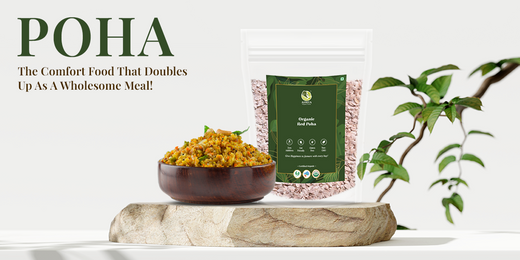Poha Calories, Nutritional Value (Per 100g) & Its Health Benefits
Info Organic 5 min read
Poha, also known as flattened rice, is a popular breakfast dish in India that has won the hearts of people of all ages. Not only is it easy to prepare, but it is also light on the stomach and rich in poha nutrition, making it a perfect choice for a healthy start to the day.
But did you know that poha can also be a great option for a balanced supper? Packed with poha nutritional value and low in poha calories per 100g, this humble dish, poha made of rice paddy can keep you full and satisfied without causing any guilt.
In this blog, we will explore the poha nutrition value, often known as aval, and how it can offer health benefits beyond breakfast. So let's dive into the poha nutrition facts or aval nutrition to discover why this flattened rice is more than just a tasty meal!
Table of Content
- Nutritional Value of Poha
- How Many Calories Are in a Plate of Poha?
- How Many Calories Are in One Cup or Bowl of Poha?
- Types of Poha & Approx. Calories
- Health Benefits of Poha Rice
- How to Make Poha for Supper
- Conclusion
Nutritional Value Of Poha
|
Nutrient |
Amount (per 100g) |
|
Calories |
~360 kcal |
|
Carbohydrates |
76g |
|
Protein |
6g |
|
Dietary Fiber |
0.87- 3g |
|
Iron |
2.7- 4mg |
|
Magnesium |
32mg |
|
Potassium |
148mg |
|
Vitamin B6 |
0.2mg |
Note: The nutritional values provided above are approximate and may vary depending on the source and specific manufacturing processes. While we strive to present accurate information, the values listed should only be used as a general guide. Always refer to the nutritional label on the product packaging for precise details.
How Many Calories Are in a Plate of Poha?
The calorie content of poha depends on the portion size, the preparation method, and the added ingredients like oil, peanuts, or vegetables. On average, plain poha contains approximately 130-140 calories per 100 grams. Here's a detailed breakdown of how calories vary based on the portion size:
|
Quantity (in grams) |
Calories (Approx.) |
|
Small Plate (100 grams) |
130-140 kcal |
|
Medium Plate (200 grams) |
260-280 kcal |
|
Large Plate (300 grams) |
390-420 kcal |
How Many Calories Are in One Cup or Bowl of Poha?
|
Quantity (in grams) |
Calories (Approx.) |
|
Small Cup/Bowl (100 grams) |
130-140 kcal |
|
Medium Cup/Bowl (200 grams) |
260-280 kcal |
|
Large Cup/Bowl (300 grams) |
390-420 kcal |
Note:
- If poha is prepared with additional ingredients like peanuts, potatoes, or extra oil, the calorie count will increase. For instance, a medium plate of poha with added peanuts and oil could range between 300-350 kcal.
- Including vegetables like peas or carrots adds minimal calories but boosts the fiber and nutrient content.
Types of Poha & Approx. Calories
Poha, also known as flattened rice, is a light, versatile, and highly nutritious ingredient, often enjoyed as a staple breakfast or snack in Indian households. Made by parboiling rice and then flattening it, poha has a unique texture and absorbs flavors beautifully. Whether in savory dishes like Kanda Poha or sweet treats like Poha Ladoo, this traditional food is cherished for its taste and health benefits.

With a nutritional value of approximately 360 calories per 100g, poha is a rich source of carbohydrates, moderate protein, and essential nutrients like vitamins B, iron, and magnesium. It is also easy to digest, making it a great choice for all age groups. Let’s dive into the types of poha and their unique nutritional profiles.
Thick Poha
Used in dishes like Kanda Batata Poha, thick poha holds its shape well when soaked.
Calories: ~360 kcal per 100g
Best for: People who prefer a heartier, more filling breakfast or meal.
Nutrients: High in carbohydrates, moderate protein, and rich in iron.
Thin Poha
Lightweight and used in Chivda (a spiced snack).
Calories: ~380 kcal per 100g
Best for: Busy individuals looking for minimal-prep options for on-the-go munching.
Nutrients: Slightly higher caloric value due to faster absorption of cooking oil.
Red Poha
Made from red rice, red poha retains more fiber and nutrients.
Calories: ~350 kcal per 100g
Best for: Health-conscious individuals, diabetic-friendly and Low GI
Nutrients: High in fiber, iron-rich, low in carbs, antioxidants, and vitamin B.
Brown Poha
Made from brown rice, it is a whole-grain option.
Calories: ~370 kcal per 100g
Best for: Low-glycemic diets and weight management.
Nutrients: Rich in fiber, protein, selenium, and magnesium.
Organic Poha
Organic poha is free from pesticides and made from organically grown rice.
Calories: ~360 kcal per 100g
Best for: Health-conscious individuals preferring clean, natural foods.
Nutrients: Retains vitamins and minerals with no additives.
Health Benefits of Poha
Are you looking for a nutritious and delicious breakfast option? Look no further than poha or aval, the flattened rice that has been a breakfast staple in India for generations! Not only is it easy to prepare and incredibly satisfying, but it's also packed with poha nutrients and health benefits.

- One of the most significant poha health benefits is its ability to improve digestion. The high fiber content in poha helps regulate bowel movements and keeps you feeling fuller for longer. Additionally, poha contains antioxidants that can promote heart health by reducing inflammation and improving blood flow.
- If you're looking to manage your blood sugar levels, poha can be an excellent addition to your diet. It has a low glycemic index, which means it releases glucose into the bloodstream slowly, preventing spikes and crashes in blood sugar levels. Plus, the protein in poha can help stabilize blood sugar levels even further.
- But that's not all - poha is also a rich source of essential vitamins and minerals, including iron, potassium, and calcium. These nutrients are crucial for maintaining healthy bones, muscles, and overall well-being.
So next time you're in need of a quick and healthy meal, consider adding poha to your diet. With its nutritional value and numerous health benefits, it's no wonder aval is a popular breakfast dish in India and beyond!
How to Make Poha for Supper
Let’s explore some facts on how to make aval or poha for supper, sharing different recipes that are not only delicious but also nutritious. Whether you're a beginner or a pro, these recipes are easy to follow and will satisfy your cravings for a flavorful and wholesome meal.

- Masala Poha: Start by heating oil in a pan and adding mustard seeds, cumin seeds, and curry leaves. Then, add chopped onions, green chilies, and grated ginger. Once the onions are golden brown, add turmeric, salt, and aval. Mix well and cook for a few minutes. Finally, add lemon juice and coriander leaves for a burst of flavor.
- Vegetable Poha: Heat oil in a pan and add mustard seeds, cumin seeds, and curry leaves. Then, add chopped onions, green chilies, and grated ginger. Once the onions are golden brown, add chopped carrots, peas, and potatoes. Cook for a few minutes before adding poha. Mix well and cook for a few minutes. Finally, add lemon juice and coriander leaves.
- Sweet Poha: This is a great option for those with a sweet tooth. Start by soaking poha in water for a few minutes, then drain the water. In a pan, heat ghee and add chopped nuts like almonds and cashews. Then, add the soaked aval and mix well. Add sugar and milk, and cook until the milk is absorbed. Finally, add cardamom powder and raisins for a delicious and healthy dessert-like supper option.
Conclusion
Poha isn’t just a deliciously versatile dish, it’s a powerhouse of nutrition too! Packed with essential nutrients like protein, iron, and fiber, it’s a wholesome addition to your diet. With only about 360 calories per 100g, poha is both light and satisfying. Plus, it’s rich in vitamins like B-complex, and minerals such as magnesium and phosphorus, making it a smart choice for your health.
But poha is more than just its nutritional benefits. Its warm, comforting flavor turns any meal into a delightful experience. So, the next time you’re planning a healthy and hearty supper, consider adding poha or aval to your table. It’s not just food, it’s a taste of tradition served with love.

